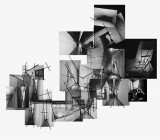Supervisors:
2007
The matter of finding new ways both of reading and formulation of meaning to any space is used as a basis for the creation of this paper. Its main aim is the foundation of a code based on the human body, which will be able to attribute the spatial perception and experience of people thought multiple types of syntax. This tool of analyses is not expected to appear as a new method; it arises from the already existed qualities of the body.
The observation of the human body in a dance performance of the so-called “Black Theatre” of Prague was the motive for the realization of this idea. This event was consisted of choreographies in which the body appeared as a whole of fragments on a black stage. In such a black scenery, deprived of any spatial quality, it was realized that the visible parts of the body worked as spatial “patterns” which were constantly redefined, thus allowing the creation of alternative analyses. Boundaries, height and depth, all being expressed through the bodies of dancers-actors, were turned into easily-shaped parameters in the perceptual skills of the audience. The viewers were not just passive readers but as carriers of embodied knowledge and memory, they participated in the performance in an indirect way. The immediate spatial experience by the actors worked as a tool of analyses and turned the performance into a personal experience of the viewers. The entire understanding of the stage is formed after the end of the performance, as the unification of all this fragmental corpo-spatial events and perceptions. This unification does not have a tactile spatial construction but consist of a mental approach and analyses.
This specific experience was attempted to be mapped and described through abstract conceptual models. The deriving structures are thought as two-dimensional, and in-virtue three-dimensional, representations of the indirect live-in experience and form a code of communication between body and space. This recorded experience is constantly developed and modified in the viewers’ conscience, thus urging them to reconsider the way they conceptualize and organize the space.
This new way of communication between body and space is called “the fragmentation code” and is defined as the interconnection of sectional (spatial) concepts, which are formed by a whole of spatial aspects redefined through the appropriate somatic parameters.
The new way of expression is attempted to be applied in art too, as an alternative way of reading the paintings. This aims at coming to a safer conclusion, which will encourage the application of the fragmentation code on different fields of expression, especially architecture.
This essay is completed with the analyses of the inner space of the Hebrew Museum of Berlin, using the terms of “fragment” and “fragmentation”.
The fact that the visitors do not think of the inner building as a series of continuous spatial conditions, but as a whole of fragmental spatial snapshots was the motive of analysing the Hebrew Museum. This seemingly chaotic structure finds ways to be assembled in the observers’ memory –after the end of their visit- and be finally organized as an absolutely clear move. After having listed those spatial points that were considered to be memorable by the visitors’ conscience, the element that works as a common point of reference and connection among them, was enquired. It was thus realized that the beginning of every reading, the meeting point of all is the human body, working as a motive of observation and formulation of meaning of space and as a carrier of embodied spatial memory and experience.
This wandering in the Hebrew Museum was formed through abstract conceptual shapes and thus a new type of notational system was created. This new corpo-spatial code of communication, consist of a new vocabulary inspired by the already materialized notational language of the architect and represents the corpo-spatial experience and conception.
However, this code brings to mind an earlier written language that the architect created in a series of sketches, the Micromegas, about 15 years.
It’s about an encounter of these two vocabularies in retrospect that, even thought entirely coincidental, seems to verify the application of the new code in spaces where the human body does not directly involve, but it is implicit in different ways of expression.
The implement of the fragmentation code, in Micromegas gives an end to the searching for founding new ways of observation and conceptualization in every-day space, which would rely on human body. The fragmentation code seems to work as an appropriate tool for analyses, formulating of meaning, and organizing spaces, which can be seeked in many expression fields, and especially in architecture, not only in “special-type” buildings, but in the every-day space too.
